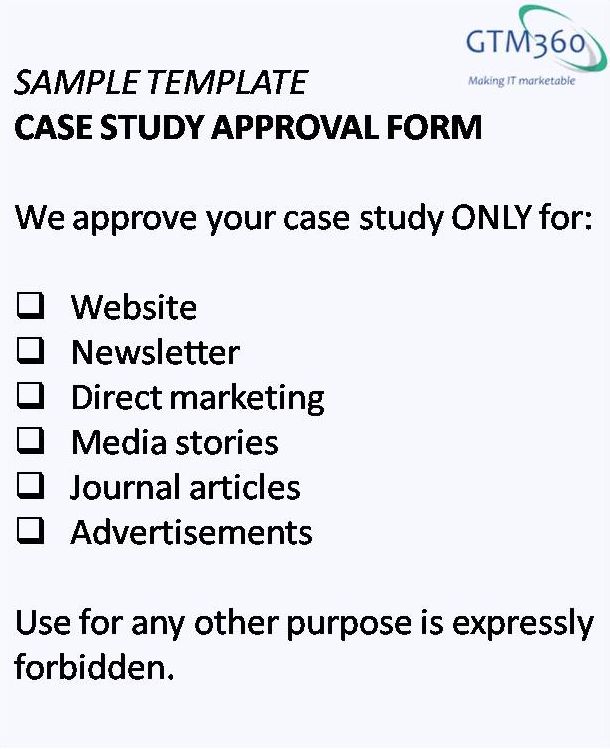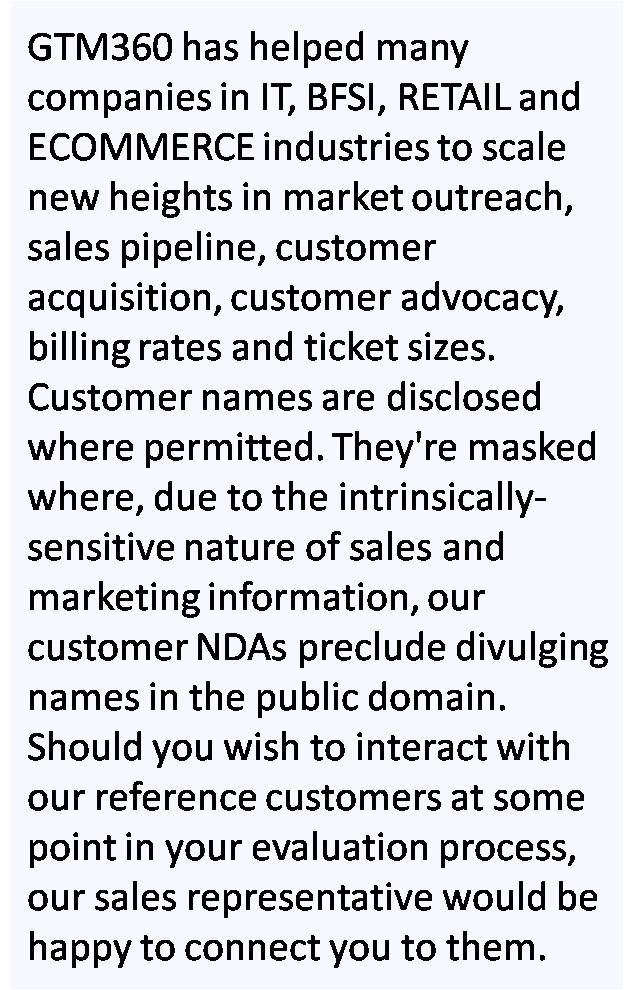In Right And Wrong Ways Of Using Case Studies, we saw when to use case studies and when not to.
Let’s now assume that a technology vendor has reached a certain stage in the sales cycle when it is appropriate to use case studies.
Building an inventory of ready-to-use case studies can be a challenge when customers are reluctant to issue approvals for them. In this post, we’ll share three ways to overcome this challenge:
- Restrict circulation channel
- Alter benefit proposition
- Masking
#1. RESTRICT CIRCULATION CHANNEL
 The moment you mention case study, many customers think you’re going to publicise your relationship with them all over the place. Based on that perception, they tend to decline your case study for reasons like “I’m not authorized to talk to the press”, etc.
The moment you mention case study, many customers think you’re going to publicise your relationship with them all over the place. Based on that perception, they tend to decline your case study for reasons like “I’m not authorized to talk to the press”, etc.
You can convert such reluctant customers by offering to restrict the channels in which the case study would be circulated.
Send them the case study with an approval form (per template given on the right). In the form, list all channels viz. website, newsletter, DM, media stories, journal articles, ads, etc. Ask the customer to check which channels they’re okay with.
You’ll be pleasantly surprised to find that even the most reluctant of customers will check at least one or two boxes in this form.
Some channel is better than no channel.
#2. ALTER BENEFIT PROPOSITION
In a Digital Marketing campaign conducted for a Bank, the ROAS (Return On Advertising Spend) delivered by various channels was as follows:
- Retargeted Ads: 30
- Search Engine Marketing: 14
- Email Marketing: 12
- Social Media Marketing: 5
We wrote up the case study with the following two variants of the benefit statement:
- Statement A (Identified): Ms. Jane Doe, the head of marketing of ACME Bank, found that Retargeted Ad delivered an ROAS of 30, which was 2X of their next best performing channel.
- Statement B (Masked): The head of marketing of a leading Bank found that Retargeted Ad delivered an ROAS of 30, which was 2X of their next best performing channel.
As you can see, the customer company and contact were identified in the first version and masked in the second.
NOTE: While the customer’s name and industry are changed to preserve confidentiality, the above mentioned figures are factual.
We sent both versions to Ms. Jane Doe. She came back with the following statement:
Statement C: Ms. Jane Doe, the head of marketing of ACME Bank, found that Retargeted Ad delivered twice the ROAS of their second best performing channel.
If you notice, Statement C is more powerful than Statement B because it identifies the customer and contact by name but is less detailed than Statement B because it does not mention the ROAS figure of 30.
In an ideal world, everyone would love to have Statement A in their marketing arsenal. However, there are many extraneous factors driving case study approvals in the real world. Therefore, even if the benefit proposition is slightly diluted in Statement C, it’s still useful.
End of the day, some benefit statement is better than no benefit statement.
#3. MASKING
There are times when a customer is not prepared to draw attention to their company in any form. This can happen, for example, when a company uses a certain technology to gain competitive advantage and doesn’t want to alert its competitors to its plans prematurely.
All is not lost.
Marketers in this situation can develop masked case studies. Here you don’t reveal the name of the customer. Instead, you use a “surrogate” expression to refer to the company.
For example, if you’ve supplied a payments software to Barclays Bank, you’d say “payments software for a Top 5 UK Bank”.
Note that we’ve said “Top 5” even though the bank in question is the largest bank in the United Kingdom. This is the key in using the masking technique. You can’t be totally vague and say “UK company”. Nor can you be totally specific and say “largest UK bank”. It’s important to strike the right balance between the two extremes.
While a masked case study is less effective than a named case study, it might be the most practical way forward at certain times.
Even leading companies use them regularly.
- Take Infosys for example. There are 16 case studies under Financial Services. Fourteen of them are masked. Nomura and UBS are the only two companies identified by name.
- Airtel is another example: In a print ad, the leading MNO uses the rather plain-sounding surrogate “a leading bank” to mask the customer for its Intelligent Connectivity Solutions.
Remember that a masked case study is better than no case study.
That said, savvy marketers know how to get selective approvals to unmask their masked customers.
Apart from the tactics described above, there are many other ways to secure a reluctant customer’s approval for case studies, such as “time-shifting”, and so on. However, their applicability is determined on a case-by-case basis. Therefore, we haven’t covered all of them in this post. If you’re facing a challenge with a specific case study, please feel free to contact us for guidance.

